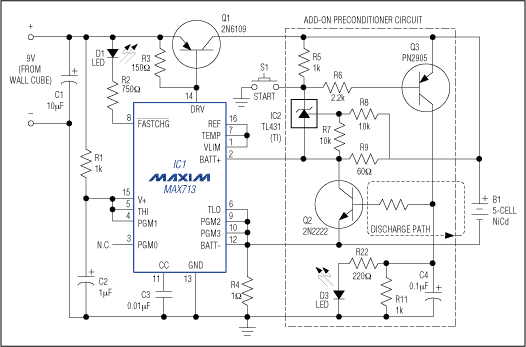
Thus, a full discharge eliminates the reduction in terminal voltage that is sometimes (erroneously) called the "memory effect." The circuit in Figure 1 "preconditions" a battery by fully discharging it (to approximately 1V per cell) before initiating a charge cycle. The preconditioner is within the dashed line (it also operates with other battery-charge ICs or as a stand-alone circuit), and the remaining circuitry is a conventional NiCd battery charger based on IC1.

Figure 1. This add-on preconditioner circuit for NiCd battery chargers eliminates the so-called memory effect by fully discharging a battery before recharging it.
Until preconditioning is initiated by a momentary depression of S1, the charger circuit operates normally: The 5-cell battery has a capacity (C) of 500mAhr, and R4 configures IC1 for a fast-charge rate of C/2 (250mAhr for two hours). Following a fast charge, the circuit delivers a trickle charge of about 33mA.
Depressing S1 turns on Q3, which initiates battery discharge by turning on the preconditioning load Q2. Current through R9 produces a control voltage for the shunt regulator IC2. For values above 2.5V (battery above 5V), IC2 remains on and sinks current, holding Q3 on when S1 is released. When the battery voltage discharges to 5V (1V per cell), IC2 turns off and ends the preconditioning cycle. The circuit requires about 10 hours to precondition (fully discharge) a fully charged battery. It then recharges the battery automatically, in about two hours.
The IC normally enters fast-charge mode when you apply power or install a battery, but (as a safety measure) it does not begin or continue the fast charge if the battery voltage is below 0.5V per cell. Note that fast charging is disabled during the preconditioning cycle, because the battery-sense terminals (pins 2 and 12) are clamped by the VCE(SAT) of Q2. IC1 maintains a trickle charge during the preconditioning cycle, so you must account for the 33mA trickle current when calculating the value for R9.
As shown, the 60Ω value for R9 draws 83mA at 5V. Nearly 33mA of that is trickle current, so at 5V, only 50mA comes from the battery. (As mentioned, this 50mA discharges a fully charged 500mAhr battery in about 10 hours.) Thus, when modifying the circuit for other cell counts, preconditioning times, or trickle rates, you must account for trickle-charge current in the calculation of R9.
Shunt regulator IC2 includes a 2.5V bandgap reference that limits the circuit to applications of three cells or more. For lower cell counts (with some sacrifice of accuracy and temperature performance), you can substitute an npn transistor for IC2 and set the R8/R7 divider to produce one base-emitter drop.
A similar version of this article appeared in the January 22, 1996 issue of Electronic Design magazine.
欢迎分享,转载请注明来源:内存溢出

 微信扫一扫
微信扫一扫
 支付宝扫一扫
支付宝扫一扫
评论列表(0条)